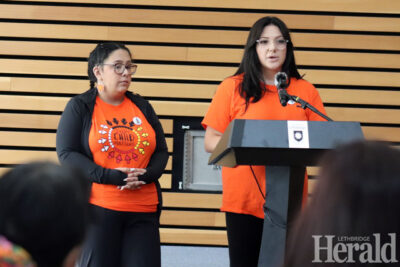University memorializing residential school victims through planting project
By Alejandra Pulido-Guzman - Lethbridge Herald on September 30, 2022.
 Herald photo by Alejandra Pulido-Guzman
University of Lethbridge student Cierra Ross speaks along with Aysha Partington about the Roots of Growth project during a ceremony Thursday at the University of Lethbridge Markin Hall.
Herald photo by Alejandra Pulido-Guzman
University of Lethbridge student Cierra Ross speaks along with Aysha Partington about the Roots of Growth project during a ceremony Thursday at the University of Lethbridge Markin Hall.LETHBRIDGE HERALDapulido@lethbridgeherald.com
A student-led project that aims to memorialize the victims and survivors of residential schools by planting trees across the University of Lethbridge campus launched Thursday.
The Roots of Growth project launch ceremony took place in the Markin Hall after rain forced those in attendance to leave the original location of The Grove.
During the ceremony students and project leads Aysha Partington and Cierra Ross spoke to those in attendance about the project.
Partington touched on the history of residential schools and said there were approximately 130 schools across Canada where about 150,000 Indigenous children are believed to have attended, and between 4000 to 6000 of those children never made it back to their families. Those numbers are believed to be a low estimate.
She explained that residential schools attempted to destroy the culture, language, traditions, and identities of Indigenous peoples across Canada.Â
Partington said that after the discovery of unmarked graves found in former residential school sites, First Nations communities across Canada are starting to process and uncover their own.
“The fatality rate of children who died in residential school is higher than that of Canadian soldiers in World War II,” said Partington.
She said the project refers to The Truth and Reconciliation Commission’s calls to action, specifically to #74 which reads “We call upon the federal government to work with the churches and Aboriginal community leaders to inform the families of children who died at residential schools of the child’s burial location, and to respond to families’ wishes for appropriate commemoration ceremonies and markers, and reburial in home communities where requested.”
Ross explained that they wanted to plant four trees as a proper burial and to give recognition to the children who went missing and never made it home, for the surviving, and for the ones who never got a chance to tell their story.
“We chose trees because they are a vital connection between human beings and the earth. We want to inspire reconnection to the land. Cultural wounds require cultural medicine,” said Ross.
She explained they chose four trees to represent the sacred number four and the medicine wheel.
Ross added that memorial trees symbolize new beginnings for them and those trees give back as a circle of life, in Indigenous culture they are very connected to the earth and for them the earth is everything.
“We wanted full grown trees to represent that history has already happened, but it’s how we move forward from here. The roots of the trees represent these intergenerational traumas that residential schools created, the children who experienced horrific acts of violence and were made to feel like they could not talk about their experience or they were not believed, the families ripped apart and expected to continue to live ‘a new normal’, the kids who were forever silenced, this is for them,” said Ross.
She said trees survive all storms and just like a tree we must stand tall and continue to grow, and just like the poppy on Remembrance Day, they created pins. The pins showcase a tree with a braid as a trunk and the roots go in a circle around it.
“We want to wear them on this day uniting us together as a community and to help bridge the gap. We want to show our support to those affected because we are the future and this is for future generations,” said Ross.
She said this is just the first step, they want to eventually plant trees at every residential school site starting here in southern Alberta.
“I know people have mixed thoughts on the residential school sites, that some people think they should be torn down because there is dark history, but realistically, that is part of all of our history, that is Canadian identity. Those little kids that got taken away from their homes, stripped of their culture they remain there, and it is up to us to give them a proper memorial, to give peace to those involved,” said Ross.
She said we need to save those places as a reminder, so this never happens again.
“That is how we move forward together as a community. We cannot have reconciliation without the truth, and it starts with us starting a conversation. It starts with us promoting Indigenous ways of knowing,” said Ross.
Follow @APulidoHerald on Twitter
22-21


